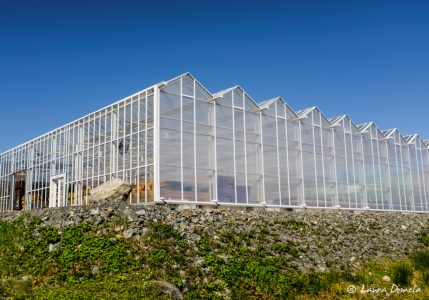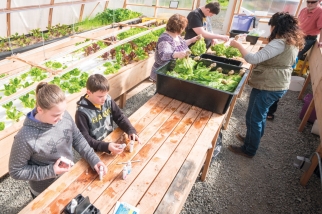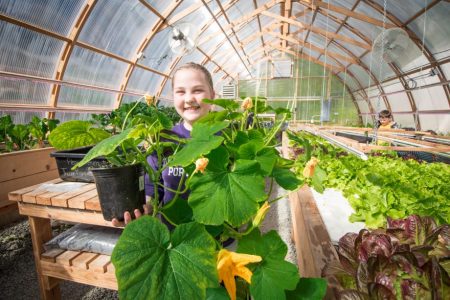Southeast Island School District
The Southeast Island School District (SISD) covers 7 communities on Prince of Wales Island, Port Alexander on Baranof Island, and Hyder next to the Canadian border. Although large in size the district serves around 160 students in these diverse areas. Within the district we have 4 greenhouses with a 5th on the way to being completed. These sites have gardens, flocks of chickens, and the district maintains an orchard. The school district has worked with many partners to make these facilities possible and were grateful to participate in the development of Biomass-Heated Greenhouses: A Handbook for Alaskan Schools and Community Organizations. As the Greenhouse and Agriculture Program Manager I have the opportunity to work with stakeholders to make these wonderful facilities succeed. I would like to highlight each of these sites, give an overview of district goals, and preview future steps.
Coffman Cove
The largest greenhouse is located in Coffman Cove and is roughly 7,000 square feet. This greenhouse runs hydroponically and will be producing throughout the winter. This is thanks to a biomass boiler system that warms the water that circulates through the floating rafts. Similar boiler systems are used at the other school sites to both heat the schools and their greenhouses. Bees have so far been unsuccessful but plans are made to try again this spring. Coffman Cove also boasts an orchard and large gardening area. We are also in the process of developing mushrooms in large cargo containers on site.


Floating Rafts in the Greenhouse
Kasaan
Kasaan is the northernmost of the Haida villages and is home to the Barry C. Stewart Kasaan School. We have partnered with the Organized Village of Kasaan to grow Haida/Tlingit potatoes. See the posted link for a wonderful history of these potatoes https://sustainablesoutheast.net/tlingit-and-haida-potatoes-eyes-into-a-unique-history/. This greenhouse produces using aquaponics with goldfish and koi. The students enjoy the interaction with the fish and learning about ecosystems using a living model.

 Students Harvesting and Kasaan Greenhouse with totem pole in background.
Students Harvesting and Kasaan Greenhouse with totem pole in background.Naukati
Naukati is located on the northern end of Prince of Wales Island and has a similar greenhouse setup as Kasaan. This site has had some setbacks with its fish but is currently on its way to reintroducing fish into the system. The needs of fish and plants are not identical and the balancing act of aquaponics can be a challenge.

 Root structure in Naukati Greenhouse and Happy Gardeners
Root structure in Naukati Greenhouse and Happy GardenersThorne Bay:
Thorne Bay is home to the district office and the largest school in the district. This greenhouse is a lean-to design that is attached to the large wood boiler/wood storage warehouse. The produce from this greenhouse is used at the school and excess sold to the community. This site enjoyed a large bumper crop of tomatoes this year!


Other School Sites
Other school sites focus on agriculture activities through the district’s curriculum and local adaptation. This spring we are having our first district “Grow Off” where students at all locations can participate in growing the largest vegetables given a few parameters. A few sites are engaged in food preservation activities and are putting in school/community garden sites. Whale Pass School focuses on heritage breeds of chickens, selling both Javan and Icelandic chicks. Hollis School is finishing their greenhouse with plans for an outdoor kitchen.


District Goals
Each of these school sites are involved in developing a propagation protocol for the threatened yellow cedar that has been on the decline here in Southeast. They all develop business plans that center on the needs of the community and feed into our “Island Fresh: Student Enterprises”. Students track expenses and revenue as a part of this program. This year we rolled out curriculum based on these activities and plan to continually make improvements as we move forward. This curriculum can be found on SISD’s curriculum website https://sites.google.com/a/sisd.org/curriculum/. We believe that the greenhouse and agriculture program here in the district enriches curriculum and creates independent thinking needed for tomorrow’s economy. We believe that we are making our local communities more food secure but also improving the health of our people..
Future Steps
SISD has been progressive in educating and putting students first. We have learned much from our setbacks and want to be a resource for schools across Alaska. Our move into mushroom production and expansion of yellow cedar propagation will help us meet the needs of students. Another step we are taking is creating community-composting opportunities to lessen food waste and create gardening opportunities. This spring we are planning a large plant sale that includes both starts and flowers. A large project we are undertaking is the Harvest Fair to take place the fall of 2018. We want to encourage local production and celebrate our unique area. Lastly we hope to use local sources of fertilizer for our greenhouse systems. We are currently looking for partnerships to explore the use of commercial fish waste in hydroponic/aquaponic systems. By conducting this research we hope to help communities in Alaska to produce more with local resources.
Follow us on Facebook at: https://www.facebook.com/IslandFreshSISD/
nice post